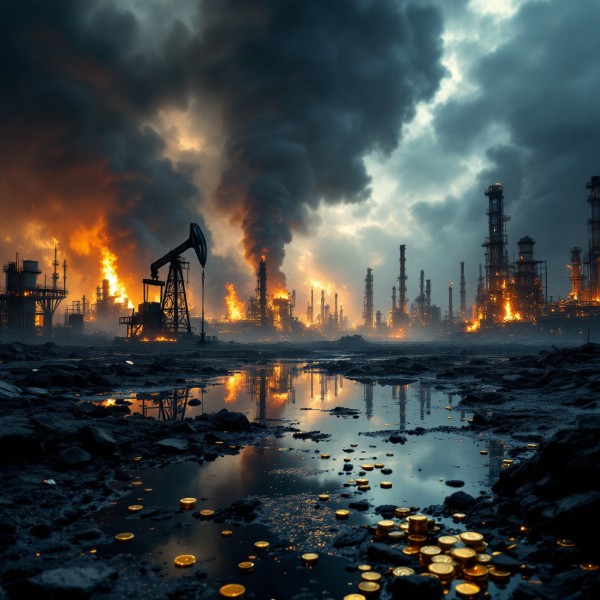The 2020 Oil Crisis: How Chaos Became a Goldmine for the Savvy
Feb 24, 2025
Introduction
The 2020 Oil Crisis was more than just an economic anomaly—it was a chaotic crucible that transformed uncertainty into opportunity. When global oil prices spiralled into negative territory and panic gripped energy markets, a savvy few saw beyond the immediate turmoil. They recognized that within chaos lay the seeds of a goldmine. This essay embarks on a relentless, high-energy exploration of how the 2020 Oil Crisis became a playground for tactical investors. With an infusion of mass psychology, contrarian thinking, and advanced technical methodologies, we will unravel how daring market players turned disaster into profit. Prepare to discover how strategic options play and precision technical analysis enabled these investors to harness volatility and capture massive gains with finesse and class.
The Anatomy of the 2020 Oil Crisis
In early 2020, the global economy was suddenly and dramatically disrupted by the COVID-19 pandemic. As oil demand plummeted and supply chains were thrown into disarray, oil prices experienced a historic collapse. In a surreal twist, West Texas Intermediate (WTI) crude oil futures plunged below zero—an outcome once considered impossible. A perfect storm of factors drove this aberration:
Massive Demand Destruction: Lockdowns and reduced travel cut consumption drastically.
Supply Glut: Oil-producing countries ramped up output amidst falling demand, intensifying oversupply.
Logistical Challenges: Limited storage capacity exacerbated the collapse, forcing traders to offload physical contracts at any price.
Market Fears: A frenzied market response amplified panic selling as investors scrambled to exit positions.
For traditional market players, this crisis was an overwhelming setback. But for the bold and the strategic, the mayhem presented a unique chance to buy into the energy sector at a fraction of its intrinsic value.
Mass Psychology: The Emotional Turbulence in Oil Markets
During the 2020 Oil Crisis, market behaviour was dictated largely by fear and collective hysteria. Mass psychology took centre stage as anxious traders and investors reacted to rapidly shifting market sentiments. The fear of further losses led to frantic selloffs, creating deep, temporary depressions in oil stocks and related energy securities.
Savvy investors recognized that such overwhelming pessimism often drives prices far below their fundamentals. By understanding the crowd’s emotional patterns, these contrarians could instruct their strategies with surgical precision. Instead of succumbing to the tidal wave of panic, they positioned themselves to capture the inevitable rebound. In short, while the masses wavered under fear, the tactical investor calmly dissected market data to distinguish between emotional overreaction and genuine structural weaknesses.
Strategic Contrarian Thinking: Seizing the Moment
Contrarian investing is more than just playing the opposite side of the market; it’s about identifying opportunities where others see only catastrophe. During the crisis, many investors shunned the energy sector entirely, convinced that the downward spiral would never end. However, astute market players saw that the panic was temporary and that the fundamentals of quality oil companies remained intact despite short-term turbulence.
This strategic defiance enabled them to take advantage of market mispricing. When nearly every oil stock fell into oblivion, companies with strong balance sheets and resilient operational models became available at bargain prices. The disparity between the market’s emotional reaction and the intrinsic value of these companies created a fertile environment for tactical plays that could generate outsized profits once sentiment normalized.
Tactical Leverage: Options Trading Breakthroughs
Beyond traditional stock purchases, innovative traders exploited the crisis using sophisticated options strategies. One of the most potent tactics was creating free leverage through options trading—specifically, selling put options on quality oil stocks when deeply oversold.
Take, for instance, a scenario involving Occidental Petroleum (OXY). As the crisis deepened, Occidental’s stock price sank sharply due to widespread panic, despite the company’s solid fundamentals and long-term growth prospects. Recognizing this disconnect, tactical investors sold put options on OXY at a price level slightly below a key support threshold. By doing so, they collected a substantial premium, effectively reducing their net acquisition cost.
But the strategy didn’t stop there. Rather than pocketing the premium as pure profit, these investors reinvested a portion of it into LEAP call options, which are long-term derivatives that give them the right to purchase Occidental at a favourable strike price later. This move created a non-linear payoff structure: profit potential skyrocketed as the market recovered while downside risk was mitigated by the premium received. In effect, these traders turned an imminent loss into a dual-engine profit machine, capturing the stock’s eventual recovery and the amplified gains from leveraged calls.
Advanced Technical Analysis: Charting a Rebound
Advanced technical analysis achieved precision in the chaos of the oil crisis. When prices dropped at record speed, indicators like the Relative Strength Index (RSI), Moving Average Convergence Divergence (MACD), and Bollinger Bands provided crucial insights into market turning points.
For example, while Occidental and other robust oil stocks traded in the red, their RSI values dropped into oversold territory (often below the critical level of 30). This technical signal indicated that the stocks were overpurchased by the selling frenzy rather than reflecting a fundamental deterioration in the company’s value. Lower trading volumes coupled with pronounced technical overshoot signaled an impending rebound—a moment when contrarian investors could step in confidently.
Furthermore, chart patterns such as double bottoms or bullish divergence on MACD highlighted potential reversals. When corroborated with macroeconomic data suggesting that oil demand would eventually recover, these patterns reinforced the thesis that the crisis-induced depression was temporary. As the market slowly stabilised, technical analysis allowed savvy investors to time their exits perfectly, turning short-term volatility into sustained gains.
Tactical Implementation: Merging Strategy with Execution
Turning a contrarian theory into a profitable strategy requires more than just understanding market signals—it demands disciplined execution and robust risk management. Successful investors during the oil crisis implemented a multi-layered approach:
- Precision Entry Points:
Investors pinpointed oversold conditions in quality oil stocks by combining fundamental analysis with technical signals. Utilizing tools like RSI and MACD enabled them to differentiate short-term panic from long-term potential.
- Options Leverage:
Selling put options on undervalued oil stocks allowed investors to secure positions at lower costs. The premiums generated were then reinvested to fund LEAP call options, delivering a leveraged exposure that multiplied the benefits of a market rebound.
- Dynamic Adjustments:
As the market evolved, disciplined traders continually reassessed their positions. They were quick to adjust hedges, rollover options contracts, or exit positions entirely when technical signals indicated that the market was shifting from panic to recovery.
- Risk Control:
Recognizing that volatility can be a double-edged sword, these investors never over-leveraged their positions. Tight stop-loss orders, position sizing, and diversification across multiple energy stocks ensured their portfolios were resilient against further market disruptions.
Case Study: Occidental Petroleum’s Tactical Revival
Occidental Petroleum (OXY) became the poster child for chaos turned opportunity. Amidst the fury of the crisis, OXY’s share price dropped precipitously—outpacing both market expectations and its own fundamentals. While most traders cowered, contrarian investors saw a chance to deploy aggressive tactical strategies.
Consider a hypothetical timeline based on real events:
Early March 2020: As oil demand nosedived and the global panic set in, OXY’s price plummeted to levels below its long-term support. Technical indicators signalled an oversold market, and fundamentals such as strong cash flow and strategic projects remained intact.
Mid-March 2020: Tactical investors began selling put options on OXY with strike prices set just below the identified support levels. The market’s extreme bearish sentiment allowed them to collect generous premiums. Instead of taking immediate physical delivery of the stock, they used a portion of the premium income to purchase LEAP call options, thereby setting the stage fora significant upside as the market recovered.
Late 2020: As vaccination rollouts heralded the beginning of a global economic revival, oil demand started recovering. Occidental’s stock began to rebound. The LEAP calls, which had been purchased at a fraction of asserted future values, surged in price—yielding returns that outstripped the gains from holding the physical shares alone.
Outcome: Through calculated entry, disciplined risk management, and the clever use of options leverage, these investors turned an overwhelming crisis into a dynamic profit opportunity. The integrated strategy reduced the cost basis of acquiring OXY and amplified the upside when the market recovered.
This case study exemplifies a tactical triumph. It underscores how the interplay of advanced technical analysis and options tactics in times of market chaos can create a powerful framework for profiting from temporary dislocations.
Risk Management in a Turbulent Environment
No strategy, however ingenious, is without risk—especially in a crisis scenario. The aggressive tactics during the oil crisis demanded unyielding discipline and comprehensive risk management. Savvy investors safeguarded their portfolios through:
Stop-Loss Strategies: Setting predefined exit points to limit potential losses in the event of a further downturn.
Position Sizing: Allocating only a modest percentage of total capital to extremely volatile trades, averting catastrophic losses.
Diversification: Balancing exposure by investing in a basket of energy stocks and related derivatives rather than concentrating solely on one company.
Constant Monitoring: Maintaining vigilance over technical signals and macroeconomic indicators to adjust strategies as conditions evolve swiftly.
By rigorously applying these measures, tactical investors mitigated risk and maintained the flexibility to capitalize on rapidly emerging opportunities.
Conclusion
The 2020 Oil Crisis stands as a stark reminder that in chaos, an unparalleled opportunity exists for those willing to challenge conventional wisdom. While mass panic rove traditional investors into defensive positions, the savvy few harnessed the turbulent energy of the crisis to build massive portfolios. By merging contrarian insights with advanced technical analysis and innovative options strategies—such as selling put options to secure lower-cost entry points and reinvesting premiums into LEAP calls—they transformed impending disaster into a goldmine of opportunity.
This daring, feisty, and audacious approach demonstrates that true tactical mastery lies in viewing market chaos as fertile ground for breakout gains. In a time when every investor seemed to be in survival mode, those with a clear, strategic vision not only withstood the storm—they thrived. They turned the aftermath of an unprecedented global crisis into a showcase of modern trading ingenuity and relentless determination.













